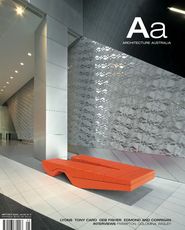WHEN YOU GRADUATED in architecture, were you able to predict who among your colleagues would be the future leaders of our profession? Were there those with potential who never seemed to realize it? Why did some go on to become leaders and others with the same educational opportunities never achieved prominence? To answer these questions, we first need to agree on what we mean by a leader of the architectural profession.
During my term as President of the WA Chapter, I had the privilege of participating as a member of the juries convened to select the winner from among the final year students of each school of architecture for a travelling scholarship. These prizes are awarded each year by two generous local architects (Peter Hunt and Gus Ferguson) to enable the recipients to travel overseas and visit many of the buildings that they have studied during their coursework. As a selection committee, we agreed that the person we were looking for was someone who would be a future leader of the architectural community. Our subsequent discussions raised some interesting points regarding how we define and assess our current leaders and then how you would train young graduates to take on these roles.
Who then are the current leaders in the architectural profession? In the private sector, are they the top design architects, the most successful “marketects”, the best at business management or are they the architects who encourage individuals to form great teams, to perform at their best and create outstanding works of architecture? In the government sector, are they the most senior architects, the most strategic policy visionaries or those who act as a catalyst for determining the most appropriate procurement arrangements for major government projects? Similarly, in academia, are they the great teachers, the best administrators or those who have the ability to instil a vision for the future and a lifelong love of learning in the minds of their students?
Clearly, in each of these sectors, the leaders of the architectural community have a significant role to play. But how do we ensure that the best of our graduates have the opportunity to develop as leaders? Too often, many of the future opportunities for a young graduate are determined (or constrained) by the attitudes conveyed by their first group of employers. Rarely can a young architectural graduate choose their employer. Often they are in the position of having their future opportunities determined by the nature of the projects secured by their employer and the encouragement (or otherwise) of their supervisor.
If support and mentoring are available, they will be encouraged to proceed with their registration tutorials and practical experience. With registration achieved and a solid base of experience, over time they can gain the skills needed to become leaders in our profession. However, at present there is no structured process to provide these skills. Much of it depends on the luck of the draw in the projects secured by the firm and the knowledge, support and interest provided by their employer and supervisor. Other professions (for example law and medicine) have a far more structured approach to the progressive acquisition of the skills and knowledge required by future leaders. Each milestone is recognized by acclamation either through a title or induction, which enables those accredited in this way to be acknowledged for their achievements.
One of the key roles that the RAIA can play as the professional learned society for architects and architecture is to create the right environment to foster and nurture young leaders. One way in which we are doing this is by using our relationships with the Institute’s industry partners to gain sponsorship specifically for younger architects, for example by funding more overseas travelling scholarships for young practitioners. In years now past, many students of architecture had the opportunity to apply for government cadetships, which provided both financial support for their studies and practical experience following graduation through work placements with the assigned employer. One option currently being investigated by the RAIA is to create a similar scheme on rotation through private sector employers.
During the Year of the Built Environment, the RAIA is also taking on a key role in organizing the YBE2004 Youthquake Forum to be held during the weekend 26–28 November 2004. Youthquake will provide the opportunity for young architects, engineers, planners, quantity surveyors, facility managers and property professionals to jointly develop strategies to achieve desired outcomes in the built environment of Australia in 2050. The primary selection criteria for those attending this signature event will be their potential to become future leaders in their respective professions.
During my term as National President, I will also be encouraging the establishment of Young Architect Committees in each Chapter. One of the roles of these committees will be to encourage younger practitioners to explore the many different opportunities available in our profession and to provide feedback to the Institute on issues of interest to this important sector of our membership.
I hope these initiatives will assist the Institute to focus its efforts on the younger members of our profession and eventually to develop structured courses aimed at ensuring that all those young architects with the capability to become future leaders have the opportunity to fulfil their potential.
Warren Kerr FRAIA, HONAIA
National President RAIA















